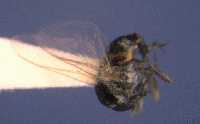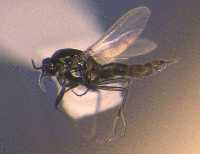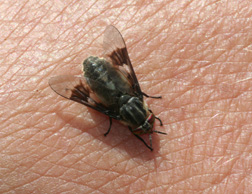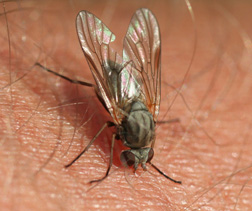by W.S. Cranshaw, F.B. Peairs and B. Kondratieff * (6/13)
Quick Facts…
- Several flies found in Colorado bite people and can be serious annoyance pests. These include black flies, biting midges and deer flies.
- Control of some biting flies is possible by treating areas where they breed.
- Problems can sometimes be avoided by personal protection measures, such as appropriately colored clothing, insect repellents, and avoiding times of day when biting is most intense.
Although mosquitoes are the best known of the flies that bite people, several other species can be locally important as a nuisance and can cause public health problems. While all biting flies are blood feeders none, aside from mosquitoes, are known to transmit human diseases in Colorado. However, some flies can transmit animal diseases. Most important, bites can be painful (e.g., deer flies) or produce swelling and intense itching as the result of injected saliva (e.g., black flies).
Black Flies, “Buffalo Gnats,” “Turkey Gnats”
 |
Figure 1: Black fly, greatly enlarged. |
The most common of the small biting flies, adult black flies can produce serious annoyance problems and sometimes produce serious effects for people and animals. In Colorado, black flies usually feed on birds and some livestock ( e.g., horses) buy may bite humans. They have been known to contribute to the death of ostriches, which react severely to the swarming gnats.
Black fly outbreaks are associated with areas with sustained running water. For example, unusually heavy and sustained spring run-off, such as occurred during 1995 in much of eastern Colorado, can contribute to large population increases and subsequent biting problems.
Adult black flies (Simulium spp.) are small with a humpbacked appearance. Approximately 40 species of black flies occur in Colorado. Only a few cause serious injury to people or animals. Simulium vittatum, a species which favors birds and is sometimes known as a “turkey gnat,” is found statewide, although concentrated in the eastern half of Colorado. The “true” turkey gnat, S. meridionale, is a foothills-prairie species in eastern Colorado and attacks birds. Species that historically have been most annoying to humans and livestock in Colorado are S. griseum and S. bivittatum. Simulium apricorium ia a pest species largely restricted to elevations above 7,000 feet, where it develops in clear, cool and often turbulent streams.
All black flies require cool, running water for development and favor sites with cobbled bottoms (pebbles, small rocks) that are largely clear of silt. The black fly larvae attach themselves to rocks or other submerged materials and feed on organic particles they filter from the passing waters. Trailing vegetation or rotted aquatic plants also are attractive to black flies, providing sites for the larvae to attach for feeding. Breeding may also occur in rivulets formed by the flooding of fields.
The black fly life cycle can be rapid, taking about three weeks from egg laying to maturation of the adult. Only the female bites, the blood meal being used to provide protein for egg maturation. Adults live about two weeks. Populations can grow very rapidly. Two to four generations may be produced annually. Individual females may lay several hundred eggs.
Adult black flies are migratory, commonly flying many miles from larval breeding sites. As an extreme example, migrations of more than 90 miles are reported in Canada.
Black fly attacks on people, cattle, horses and pigs tend to be concentrated around the ears and head. In addition to the blood loss, effects of the insect saliva can cause a variety of problems, with swelling and intense skin irritation most common. Allergenic asthma, nausea and more systemic effects can also occur, a condition known as “black fly fever.” Species that attack birds feed mostly around the eyes. The intense annoyance can cause animals to become greatly agitated and exhaust themselves in attempts to escape. Some Colorado species of black flies are known vectors of vesicular stomatitus, a disease that can infect horses, cattle and pigs.
Unlike mosquitoes, black flies are day feeders. Biting attacks tend to show some periodicity. During sunny, warm days peak attacks occur in mid-morning and then have a more intense phase in evening, ending at dusk. However, biting greatly intensifies at the onset of storms and may persist all day when overcast conditions occur.
Control
Black fly control is difficult due to the highly migratory adult stage and their extensive breeding habitat. In terms of personal protection, choice of clothing can be important. Black flies are highly attracted to dark colors, so wear light colored clothing. (Note: Male ostriches appear to have been particularly hard hit by the black flies, presumably due to their dark colored bill). Light-colored hats that cover the ears are an important precaution. The repellent DEET (diethyl toluamide) is somewhat effective in preventing black fly bites, although swarming gnats may still be annoying even when using repellent.
To reduce attacks on poultry and ostriches, keep the birds in a darkened barn during the day. Usually fans or some other means of cooling the birds is needed.
Larval control is practiced in some areas where chronic black fly problems occur and breeding areas are known. This involves metering of Bacillus thuringiensis var. israelensis into the flowing water where larvae occur. Trade names include Bactimos and Vectobac, the same products used for larval control of mosquitoes. However, as previously noted, the breeding sites can be many miles away from where the adult insects are causing problems.
Adult control is problematic, again due to the migratory behavior of the insects. It is likely that permethrin-based products are among the best. These are effective against most fly species and are labeled for use in mosquito control and for fly control of livestock.
Biting Midges, “No-See-Ums,” “Punkies” (Ceratopogonidae)
Biting midges are minute insects, often called “no-see-ums” because they are so small (usually less than 1/8 inch) that they can pass through typical porch screening. However, despite their size, they can be painful biters and highly annoying. Two common biting midges that cause problems in Colorado are Leptoconops species and Culicoides species. Each has different habits.
Leptoconcops Midges
Within Colorado, problems with Leptoconops midges are restricted to the West Slope. Historically, areas around the Colorado National Monument have reported problems most frequently and the canyon country of western Colorado. Adults bite during the day, particularly during midmorning and near dusk. Although peak biting usually occurs during a single period of the year, it typically lasts about two to three weeks, during which time outdoor activities can be greatly curtailed. Biting may also be more severe in years following periods of drought.
 |
Figure 2: Biting midge, greatly enlarged. |
Although the exact habitats where Leptoconops midges breed are unknown, it is suspected that they develop in seepage areas of crevices along canyon washes. Emergence of the adult insects usually follows late spring or early summer rains. Emergence may be delayed by drought.
Control. Because the breeding sites are widely dispersed and often inaccessible, control of larvae is impractical. Effectiveness of adult control through areawide insecticide sprays has never been successfully demonstrated and likely would produce poor results because the adult insects may fly considerable distances from breeding areas. The insect repellent DEET is effective against these insects.
Culicoides Midges
Culicoides midges are widely distributed in the state. Larvae develop in moist soil rich in organic matter. Damp areas at the edges of ponds, swamps and manure lagoons are the more favored breeding sites. Several generations can be produced each year.
Adult stages rarely fly far from breeding sites. Most biting occurs at dusk with a secondary peak period of biting at dawn. Where conditions allow, breeding adult insects can be present and produce problems for months. Culicoides variipennis and C. sonorensis are known to vector blue tongue disease of sheep and cattle.
Control. Control of larvae with insecticides is not possible due to their inaccessible breeding sites. However, some reduction of breeding is possible through cultural practices that modify larval habitat. This could include intermittently flooding and/or alternately thoroughly drying ponds that serve as breeding sites. Eliminating stagnant water rich in organic matter will help reduce breeding habitat. Careful water quality management of settling ponds associated with dairy operations and feedlots also will reduce breeding habitats.
Success of adult control is not likely and has not been demonstrated. Although these flies do not disperse great distances, adult biting midges can range widely. They tend to rest on tall grasses during the day. DEET is only marginally effective as a repellent.
Deer Flies
 |
Figure 3: Deer fly. |
Deer flies (Chrysops spp., Silvius spp.) are moderate-sized insects. Most common species are gray or light brown, sometimes with patterned bodies and wings, and have large colored eyes. Deer flies are day biters, produce a painful bite, and frequently draw blood in the process.
They lay eggs on grasses and other aquatic vegetation around the edge of small ponds and other permanent standing water. The larvae develop within the mud and plant matter around the edge of the pond, feeding on decaying organic matter and small invertebrates.
Deer flies have a one year life cycle. Adults are present for two to three weeks. They rest on shrubbery or tall grass when not mating and feeding.
Horseflies are closely related to deer flies. They are somewhat larger and generally have similar habits, although larvae are thought to be primarily predators of insects developing in mud around ponds. Horse flies found in Colorado almost never bite people but can be occasional nuisance pests of livestock. However certain horse flies found at higher elevations (Hybomitra spp.) can be nasty biters.
Control. There are no chemical controls for deer fly larvae, which develop in mud around edges of ponds and small streams. However, breeding can be suppressed by removing vegetation around pond edges to inhibit egg laying. To control adults, direct insecticides at shrubbery and other resting sites.
Deer flies and horse flies may also be trapped. The “Manitoba trap” uses a dark, heat absorbing body to attract these insects, which then are directed into a cone where they are trapped. A typical design for such a trap includes a dark painted beach ball or similar object suspended under a cone. The addition of small amounts of carbon dioxide around the trap can further
increase the attractiveness of the trap. DEET and other insect repellents are not very effective at deterring deer fly bites.
A simple form of personal protection from deer flies is a sticky white patch (Tred-NotR) attached to the back of a hat. This is quite attractive to the flies as they seek out a host and flies are captured on the patch.
 |
Figure 4: Snipe fly. |
 |
Figure 5: Stable fly. Photograph courtesy of Oregon State University Extension. |
Snipe Flies
Snipe flies (Symphoromyia spp.) are close relatives of deer flies. They are found near forested areas of higher elevations of the state. Snipe flies can be vicious biters and feed during the day.
Very little is known of the habits of these insects. Larvae of some snipe flies develop in moist soils of grassy woodlands. Others have been found in rotten wood or decaying vegetation where they are thought to develop as predators of other insects.
Stable Fly, “Biting House Fly”
The stable fly (Stomoxys calcitrans) is a blood-feeding pest known to attack almost any kind of warm-blooded animal. It is a major pest of confined livestock throughout the world, including Colorado. It looks like the common house fly except that its mouthparts are adapted for biting and sucking blood. The stable fly feeds by inserting its proboscis (beak) through the skin and then sucking blood from its host. Females can live up to a month and may require several blood meals during this period in order to continue laying eggs. It is a daytime feeder, with peak biting occurring during the early morning and late afternoon. Stable flies prefer to attack people around the ankles. It does not appear to be an important vector of any human diseases.
The immature stable fly (maggot) can be found breeding in many kinds of moist, decaying organic matter, including animal bedding, lawn clippings, and compost. The variety of breeding sites, and the fact that the adults fly several miles to feed but spend little time on the host, make it difficult to manage stable flies. Little can be done except to use repellents and
protective clothing. Specific techniques have been developed for managing stable flies in confined livestock operations. These are especially important if the livestock operation is serving as a source of stable flies for nearby residential areas.
* W.S. Cranshaw, Colorado State University Extension entomologist and professor; F.B. Peairs, Extension entomologist and professor; and B. Kondratieff, professor; bioagricultural sciences and pest management. 12/96. Revised 6/13.
Colorado State University, U.S. Department of Agriculture and Colorado counties cooperating. Extension programs are available to all without discrimination. No endorsement of products mentioned is intended nor is criticism implied of products not mentioned.
Go to top of this page.





